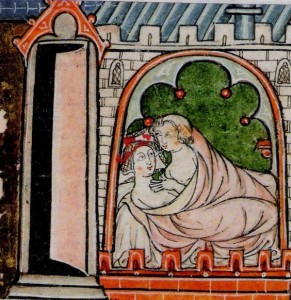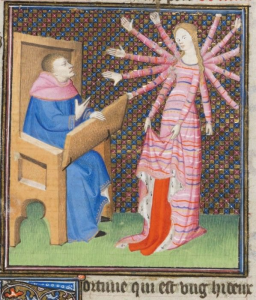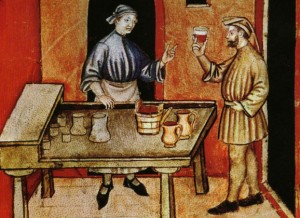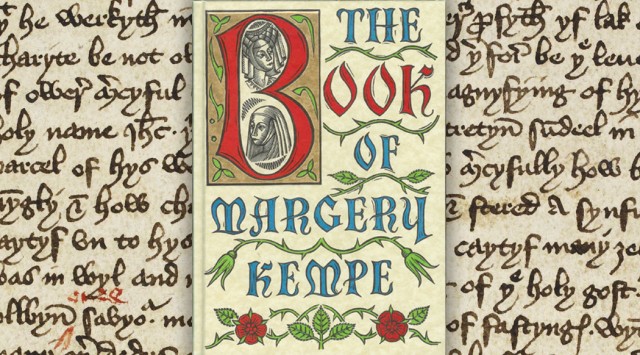Born in Norfolk, England c.1373, Magarey Kempe was the daughter of a well-to-do Magistrate. She looked set to have an ordinary middle-class life, until the birth of her first child sent her stark-raving mad.
It wasn’t having a baby that nudged her off her rocker; rather, her labour was such that she fell gravely ill and, fearing her number was up, sent for a Priest to perform the last rites. At the point in the proceedings when she had to confess her sins…she began to divulge a whopper; the Priest, shocked at the scurrilous nature of her misdeed, refused to hear it. Marg, on the edge of eternity, un-confessed and unforgiven, summarily lost the plot.
Beset with visions and convulsions of the exorcist variety, Marg was tethered in a darkened room for nearly 8 months – presumably a form of medieval psychiatry. By her own account, she was, “out of her mind and amazingly disturbed.” She scratched and bit, spoke all manner of profanities and, “desired all wickedness.”
According to Marg, she eventually came to her senses when Jesus popped by for a visit. He told her to pull herself together…and so she did. Her sanity restored, Marg returned to normal life and had 14 children. She also ran a successful brewing business; and was, by her own admission “one of the greatest brewers in town…” – that is, until her once fine head of froth went flat – her employees scarpered and the business was lost.
Next she bought a couple of horses and set up a corn-grinding mill. All would’ve been well, except for the fact that the horses, irrespective of carrot or stick, refused to walk forward – preferring instead to walk backwards. With neither man nor beast willing to work with her, Marg turned her attentions to lechery – with similar success. Having been given the come-on by a fellow parishioner, Marg – after spending a few days fighting the temptation – flung herself at him and asked would he “consent to have her.” He replied, to her horror, “not for all the wealth in this world…[I] would rather be chopped up as small as meat for the pot.”
Suitably mortified and having long teetered on the edge of a devout religious life, it seems the knock-back from Mr. Come Here Go Away, sent Marg over the edge. She donned a hair-shirt, took to fasting and praying and told her husband he could keep his baby-making, bald-headed hermit to himself.
Mr Kempe was having none of it – as was his right according to 14th century marital laws…her body was his, to do with as he pleased.

Eventually, after much cajoling, weeping and wailing, Marg got her wish, though not for nothing: Mr Kempe only agreed to a celibate marriage on three conditions:
1. They sleep in the same bed.
2. Marg pay his debts.
3. Marg make him a fish supper on Fridays.
Free from the bonds of conjugal serfdom, Marg gave herself over to a life of complete religious devotion. She and Jesus, who had been on familiar terms for many years, were now best buds. He visited and chattered with her regularly – as did Mary and various other religious figures.
No shrinking violet, Marg developed a peculiar form of public worship – which, in her own mind was a powerful, mystical experience; but, to an onlooker, more resembled a woman wailing and thrashing about in the aisle. Naturally, this made her wildly unpopular with the stiff-necked traditionalists – but Marg didn’t give a hoot, she cared only for the purity of the moment.

Inspired by the lives of other devotees, Marg decided a pilgrimage to Holy Land was in order. So off she trotted on the well-worn pilgrim’s route to Jerusalem. As any mystic worth their salt would, Marg thought the most interesting aspect of her journey were the visions and chats with Jesus she had along the way. So it is these we have records of, rather than details of the journey itself (think Scott, on his trip to Antarctica, leaving the world his dream-journal)
On her return, and following Jesus’ directive, Marg took to wandering around England visiting like-minded hermits and mystics. They seemed to have liked her well enough, but not so the church officials. At best they called her crazy; at worst, a heretic – specifically a Lollard. Back in the day, to be called a Lollard was no trifling matter.
Within the Christian world, a heretic was anyone that held ideas contrary to those of the church. While two-a-penny on the Continent, heretics were relatively scarce in England – that is, until the Lollards appeared. Followers of a man named John Wycliffe, the Lollards questioned the power and authority of the priesthood, criticised the corruption and wealth of the church, disputed substantiation (i.e. they thought communion bread was bread, and not the actual body of Jesus, as the church believed), and thought individuals should be able to read the Bible for themselves (to which end Wycliffe translated portions of the Bible into English). For such dastardliness, the Lollards were hounded by the Inquisition and, those that refused to recant, were burned alive.

That being so, you can imagine Marg’s alarm when she was chased out of a Monastery by a monk yelling, “You shall be burnt, you false Lollard! Here is a cartful of thorns ready for you and a barrel to burn you with!”
Indeed, time and again Marg was hulled before various church authorities – including the Inquisition – to give an account of her beliefs and her particular brand of worship. Lucky for Marg her beliefs were always found to be orthodox; so, while her ecstatic devotion may have been a nuisance and embarrassment to the powers that be, they had to concede that she was not in fact a heretic.
How do we know all about Marg? Well, it certainly wasn’t from church records – the church couldn’t stand her…she was a pebble in its shoe. Rather, we know all this because Margery Kempe has the illustrious honour of providing the world with the first autobiography in English – which, because she herself was illiterate, she dictated it to a Priest.
Marg’s book is without parallel in medieval English literature; lost for centuries, it was rediscovered in a private library in 1934. Its historical and religious significance are obvious; but its true worth lies in the fact that it documents the life of a truly extraordinary woman – i.e. a middle-aged housewife who ditched her husband and boring domestic life, to roam the world in search of authentic spiritual experience.
That is the magic of Margery Kempe. To be sure, she was genuinely nutty…and no doubt irritating to share a pew with; but her love of God, and ragged devotion to her unique vision, is profoundly inspiring…not to mention timeless.
If you have a personal vision – be it spiritual or artistic – and are faced with detractors and threats of public immolation, take heart…and follow Marg’s lead: look heavenward, bare your soul, and pursue your vision with all your heart…
…oh, and consider leaving the world an account of your devotion in the process. You never know when it might be unearthed and become a source inspiration for future generations.
Rebecca is a painter, collage artist and writer. Originally from New Zealand, she now lives on a little Island in the Irish Sea. She has a degree in Religious Studies and is passionate about religious history, philosophy and esoteric goings on. Her favourite research topic is peculiar religious figures; those people who, through their devotion and vision of the divine, challenged the religious establishments to which they belonged, sometimes being crushed by those establishments, other times irrevocably changing them.
You can contact her and/or find her artwork and other writing on her website rebeccaodessa.com



